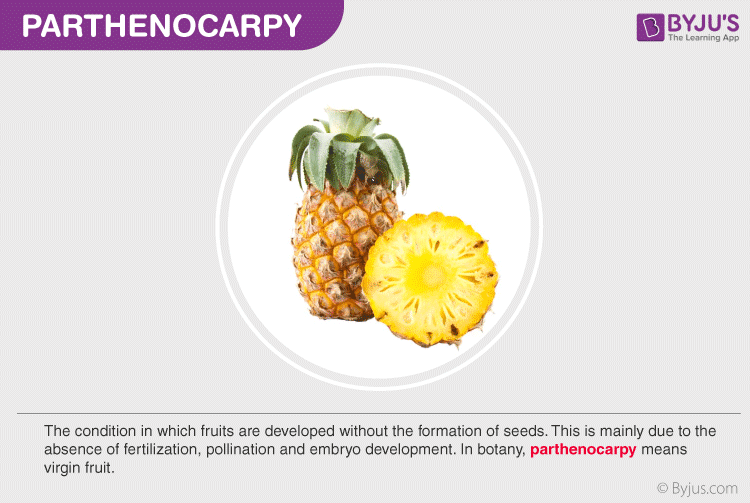“Parthenocarpy is the production of fruits without the fertilisation of ovules. Fruits like banana and figs are developed without fertilisation and do not produce any viable seeds.”

Parthenocarpic Fruits
The condition in which fruits are developed without the formation of seeds is called parthenocarpy. This process of fruit production was introduced in the year 1902. This is mainly due to the absence of fertilization in plants, pollination and embryo development. In botany, parthenocarpic fruit means “virgin fruit”. These types of fruits are generally seedless.
During cultivation, parthenocarpy is introduced along with other plant hormones including gibberellic acid. It results in the maturation of the ovaries without the process of fertilization and produces bigger and pulpy fruits. This process is applicable to all kinds of crops from varieties of squash to cucumber and a lot more.
Banana is a good example of parthenocarpy. In this natural process, the produced bananas are sterile, developed without viable ovaries and do not produce seeds, which means they must propagate vegetatively. Pineapples and figs are also examples of parthenocarpy which occur naturally.
Also Read: Formation, Parts and Types of Fruits
Parthenocarpic Fruits
Pineapple, banana, cucumber, grape, watermelon, orange, grapefruit, pear, fig are some examples of Parthenocarpy. These develop without fertilization and are often seedless.
Types of Parthenocarpy
Parthenocarpy can be categorized into two parts, which are: Vegetative and Stimulative parthenocarpy
Vegetative Parthenocarpy
This generally takes place without pollination and due to the absence of pollination, no seeds are produced within the fruits.
Also Read: Dicotyledonous and Monocotyledonous Seeds
Stimulative Parthenocarpy
Stimulative parthenocarpy generally takes place without the process of fertilization. This condition occurs when the ovipositor of a wasp is inserted into the ovary of a flower and can also be achieved by flowing air or plant growth regulators into the unisexual flowers that are present inside the syconium.
Also Read: Sexual Reproduction In Plants
Benefits of Parthenocarpy
- This is more healthy and the results are achieved easily.
- Provides seedless fruits and improves quality.
- It reduces the complete cost of the cultivation.
- This improves crop yield without using organic pesticides.
- Plant growth regulators are natural and the fruits produced are larger.
- Parthenocarpy keeps the insects and pests away without using chemicals because there is no requirement of pollinating insects for the formation of fruits. This protects the plants from being attacked by pesticides.
Also Read: Fruit and Seed Formation
Stay tuned with BYJU’S to learn more about the Parthenocarpy and parthenocarpic fruits.
Frequently Asked Questions
What do you mean by parthenocarpy?
Parthenocarpy is the artificial or natural production of fruits without fertilization. the fruits thus produced are generally seedless.
How is parthenocarpy induced artificially?
Parthenocarpy is induced artificially by the use of plant growth regulators. The development of parthenocarpic fruits is stimulated when the plant hormones such as gibberellins, auxin and cytokinin are sprayed on flowers.
Name some parthenocarpic fruits?
Banana, cucumber, grapes, oranges, pineapple are some of the fruits developed by parthenocarpy.
What is stimulative parthenocarpy?
This type of parthenocarpy occurs when pollination occurs but fertilization doesn’t. It occurs by the insertion of the ovipositor of a wasp into the ovary of a flower.
Are seedless grapes naturally occurring?
No, seedless grapes are do not occur naturally. They are produced by a form of asexual reproduction. Though, some mutant variety would produce seedless grapes naturally.

It’s creative and very educative
but how are such seeds artificially propagated? by introducing plant growth regulators only? please elaborate.
Seeds are germinated and planted in separate containers until seedlings are formed. Then, these seedlings are moved to large containers, or planted in fields. Simultaneously, the seeds can be sown directly and are allowed to grow.
Because in parthenocarpic fruit have a chemical which dissolves the seed and sometime the chemical does not dissolve the seed and the seed is visible and can be used to grow fruit
Good app